For printed plans, click HERE
a stable lightweight boat that can be fitted out for whitewater
Designed as a stable lightweight boat that can be fitted out for whitewater or casual fishing, this Clark Fork Drifter is a downsized and much simplified version of our commercial Grand Canyon dory. It can be compartmentalized for moderate whitewater or left mostly open for recreation or fishing. Scaled down to a manageable size for amateur builders, the 14 foot hull has a beam of 62 inches to provide wide stance stability for rough water and standing while casting, and with a weight of less than 130 pounds for lightweight versions it can also be cartopped to avoid the hassle and expense of a trailer. The wide-bottom hull becomes even more stable when loaded, enhanced by the rockered shape of the hull.
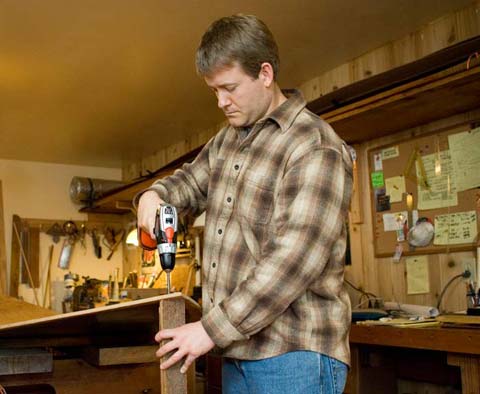
The light weight of the boat allows a larger payload, but the real advantage comes in getting the boat on and off the water. To make launch and retrieval easier the graphite bottomed boat can be dragged over parking lots, launch ramps and gravel beaches, preventing having to be lifted or trailered into the water, and the epoxy/graphite mixture is applied around the chine seam to form a waterline.
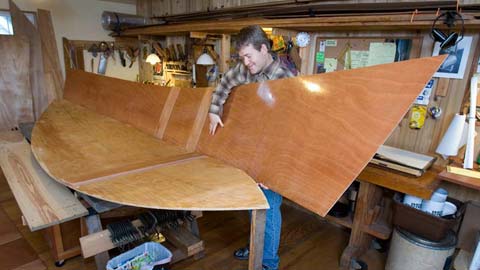
The hull is constructed by lacing together thin plywood panels with plastic ties which are gradually tightened to hold components in position while a concave shaped bead of thickened epoxy is applied to hull seams. Vertical compartment bulkheads are installed at the same time to secure hull panels at the correct angle, and fiberglass tape is subsequently applied to outside seams. Topside panels have straight line edges on top and bottom to simplify the patterning process and are joined with epoxy glued doubler pads which reinforce the hull at critical locations and provide a simple and efficient method to join the plywood.
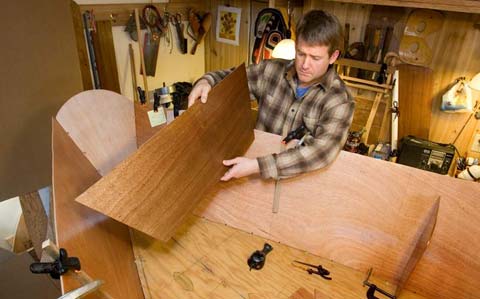
Large sealed storage compartments at each end provide structural support in the hull, secure dry storage, seating for passengers and a safety margin of emergency flotation should the hull accidently fill with water. In calm water the compartment decks can be used for seating or support while standing to cast, and also provide a handy work or picnic surface. Additional compartments can be added to boats used primarily in whitewater and are easy to build using the ply/epoxy technique, and compartmentalization options are discussed in the building plans.
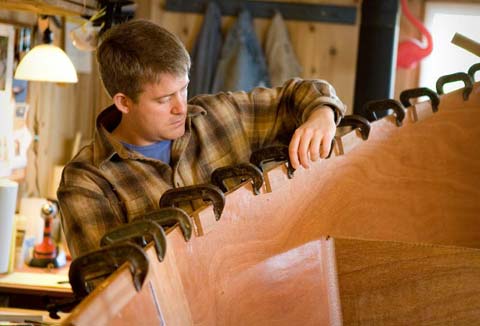
The midship seat slides fore and aft for trim to accommodate one, two or three occupants and multiple oarlock sockets are easily installed at various locations on the gunwale to adjust to various positions. The sliding seat is supported by a handy tackle shelf on each side attached to small partial bulkheads which add support to the lightweight ribless hull. The aft compartment provides an ideal seat for a passenger and there is another removable thwart seat forward. For additional comfort pivoting plastic seats with backrests can be bolted atop compartments or onto thwart seats.
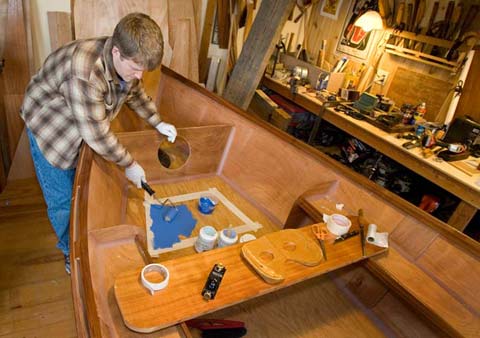
The transom can be reinforced for a motor mount and a small gas or electric motor can be fitted for covering miles or working upstream against current, and the convenient aft compartment can be built to isolate and store fuel or a battery inside a watertight compartment.
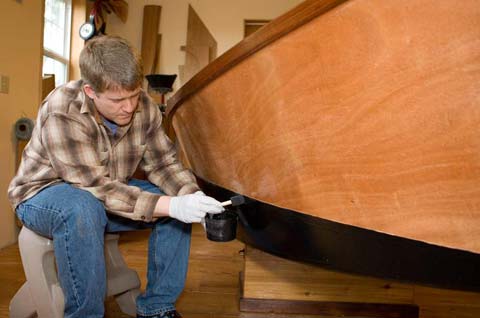
The gunwale is a traditional ladder type with spacer blocks separating inwale and outwale strips, and provides resilent stiffness to the sheerline to handle the stress of hard rowing and side impacts and also provide support when rolling the boat over for storage.
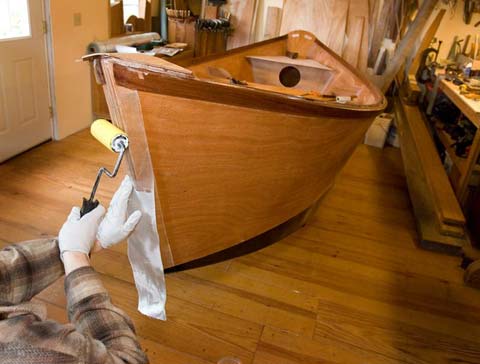
The building plans include 32 pages of sketches, photos, and detailed step-by-step all written for first-timers and amateurs. Builders tips and many options are discussed and the builder is encouraged to modfiy the boat to suit individual needs. We are also available via email. The building plans are conversational, and like the boats do not take themselves too seriously, and will be available shortly after the boat publishes in the June/July 2008 issue of Outdoor Life magazine.
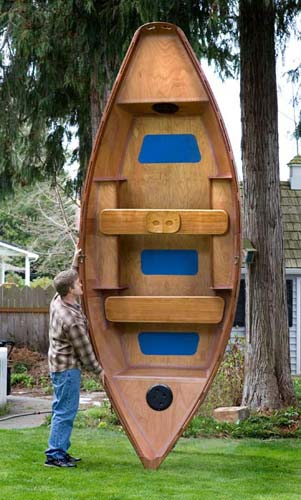
Clark Fork Drifter Customer Boats
Austin:
Paul...Thanks for all your email support as I went through this project. I love the boat!
I also created a slideshow of the construction and put it on youtube:
**********
Paulâ¦..I finished it over a winter up here in Alaska. Made it 8.3 percent bigger. Made a custom seat and a cooler for the front seat. Used okoume ply for most. Merranti ply for the sides. 9mm on the bottom and 6mm on the sides.
Aaron in Anchorage
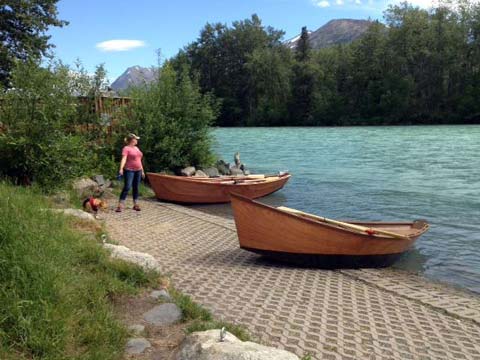
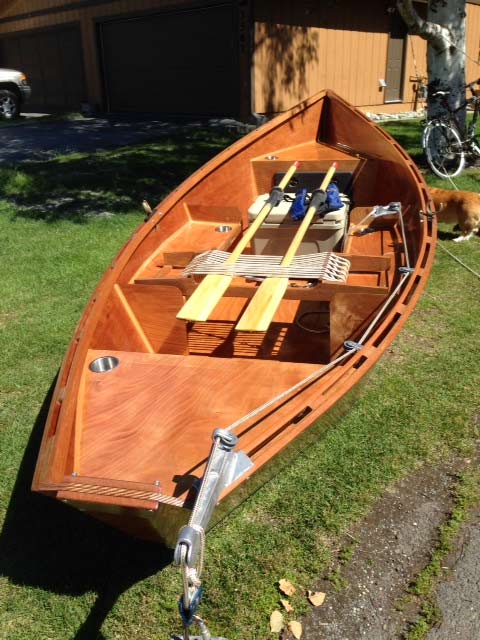
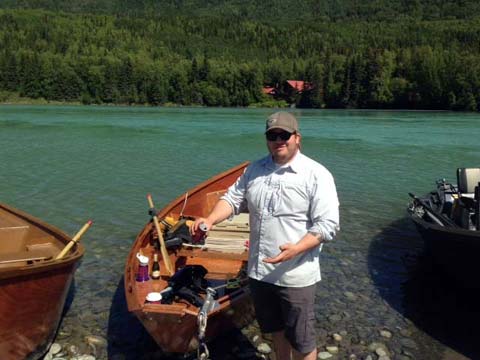
**********
Paul.....First off, thanks for all your help. I built the seats from scrap 1/4 inch mahogany ply with 1x2 cedar inside for strength trimmed with mahogany. They are light weight and absolutely rigid. I put a cap over the exposed plywood sides on the gunwales and reinforced the transom for a small motor. The non-skid on the floor is silica sand in varnish on the inside deck. It's effective and clear enough it almost can't be seen. I chose a satin for the final finish coat. In the pic I don't have the oarlocks installed but it looks great and the part I hadn't anticipated is the number of people who come to talk to me when they see it on the trailer.
Ken
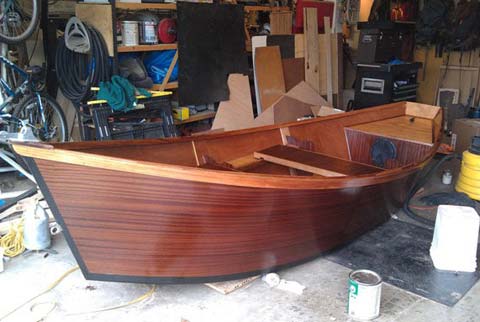
**********
Hey Paul:
Thanks again for your help and your great plans. My Clark Fork Drifter is finished and working great! Here is a photo of it on the upper Mississippi. The project went great. Some rookie mistakes, but otherwise really smooth. I built the heavier version, with 6mm sides and 9mm bottom and taped both the inside and outside of the joints. I also expanded the plans 8.3% in order to make the boat a little more spacious, since I knew I would routinely have three of us in the boat. (I'm the only one among my fishing buddies with a drifter... suddenly those two spots for each trip are in demand!) It got heavier, but feels great in the water despite that.
I couldn't be happier with the ease it rows and the balance of the hull.
Thanks for a great set of plans, and for being available when I had questions. I really appreciate it. Can't wait to figure out my next project. That Freight Canoe of yours looks great...
Thanks again,
Greg Fitz
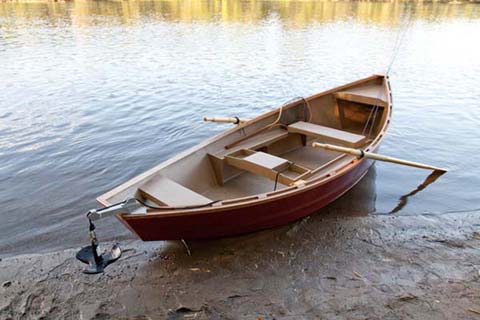
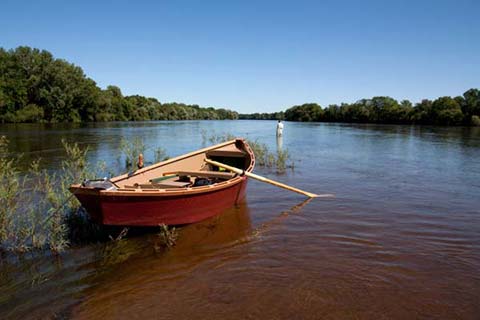
**********
Paul...... I completed the Drifter (97% anyway) in September.... had time for a run on the CO river near Moab (Dewey Bridge/Moab Daily). Worked great, got lot's of compliments and looking forward to the 2011 boating season. Attached are a couple of photos, I'll shoot for sending some better ones next spring/summer. I built in 5 compartments, hatch covers are held down with cam straps (I didn't feel like configuring hinges). The bow compartment has a round plastic hatch lid in the bulkhead and I still need to build a better seat, arrange some foot braces, and bow molding. I used a set of borrowed 10' oars, too long, now have a set of 9' that should be much better. Construction went pretty smooth, just time consuming with all the added compartments, decks, hatch covers. Thanks for putting together the design. - Sterling

**********
Hey paul, I finally got around to shooting these photos. I want to thank you for the plans, it was the first boat i ever built and i think it turned out pretty decent. I customized the plans a little and built this in my one car garage with about a foot and a half on each side. Thanks, Matthew
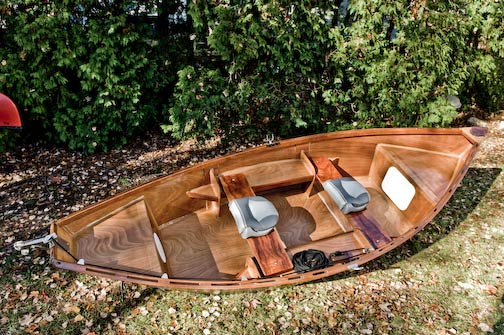
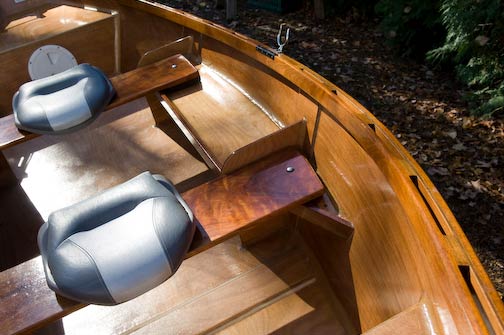
**********
See more customer boats HERE







